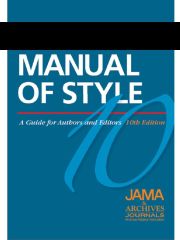Q: If a person has multiple advanced degrees, should the medical degree always be listed first, eg, MD, PhD?
A: We would advise following the author’s preference as far as the order in which degrees are listed.
Q: I know that journal names are typically italicized in their expanded form, eg, Journal of the American Medical Association. Should the abbreviation also be italic, eg, JAMA?
A: Yes. The same policy applies to book titles and their expansions. See, for example, International Classification of Diseases, Ninth Revision and ICD-9 in the list in 14.11.
Q: On page 500, in the list of journal abbreviations, is there a reason that the journal Transplantation is spelled out in full as Transplantation and yet other journals whose titles include that word abbreviate it as Transplant?
A: Yes, there is a reason. See the sentence on page 479 advising that “Single-word journal titles are not abbreviated.”
Q: The AMA Manual of Style says that tables should be able to stand independently and not require explanation from the text. Could you clarify “stand independently”? Our publication has taken this rule to an extreme, often adding lengthy definitions of terms already provided in the text. One recent example added 15 footnotes to a single table!
A: As with so many things editorial, this requires judgment. We were thinking about things like this:
- Expansion of any abbreviations, given in the text, provided again in a single footnote to the table.
- Explanation of things that might not be apparent from the tables (eg, what the various groups are if they are only identified as “group 1, group 2, etc” in the table).
- Explanation of how to convert units from conventional to SI (or the reverse), if this is important in your publication/to your audience.
- Explanation of some statistical method that would likely not be familiar to your readers without some information—the bare bones, not a lengthy explanation. If a lengthy explanation is necesssary, simply refer the reader to the relevant section or subsection of the text.
- Explanation of a phrase used for shorthand in a table stub or column head that might not be clear if all you were looking at was the table (eg, if a column head is “Unstable Vital Signs,” explain in a footnote the specific items and values that this refers to).
It truly is a question of judgment and I suspect that 15 footnotes in a single table is taking it too far.—Cheryl Iverson, MA

